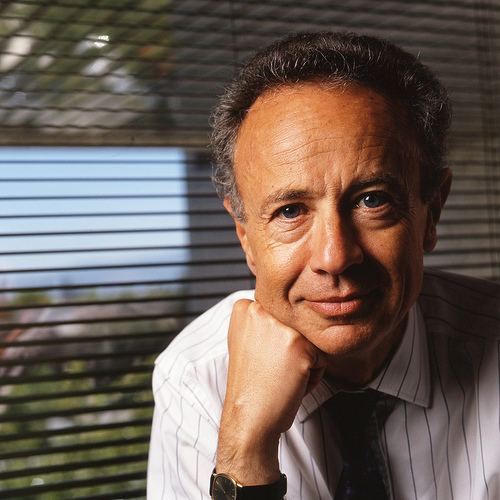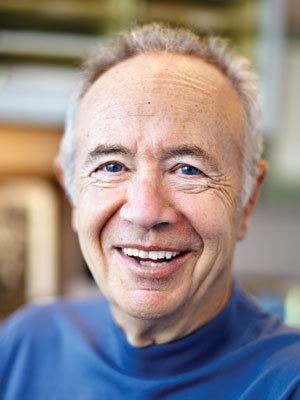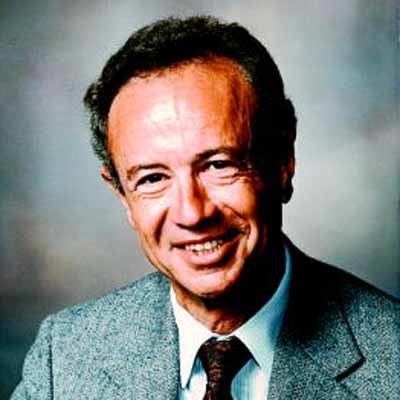Full Name Andras Grof Name Andrew Grove | Role Businessman | |
 | ||
Occupation Former COO, Chairman and CEO, currently senior advisorIntel Corporation Notable work College textbook, Physics and Technology of Semiconductor Devices (1967)Management book, Only the Paranoid Survive, (1996) Spouse(s) Eva Kastan (1958-present; 2 children) People also search for Robert A Burgelman, Tim Jackson, Marcian Hoff Books Only the Paranoid Survive, High output management, Swimming Across: A Memoir, Physics and technolog, One‑on‑one with Andy Grove | ||
Andrew grove
Andrew Stephen "Andy" Grove (Hungarian: Gróf András István; 2 September 1936 – 21 March 2016) was a Hungarian-born American businessman, engineer, author and a science pioneer in the semiconductor industry. He escaped from Communist-controlled Hungary at the age of 20 and moved to the United States where he finished his education. He was one of the founders and the CEO of Intel Corporation, helping transform the company into the world's largest manufacturer of semiconductors.
Contents
- Andrew grove
- Former intel ceo and chairman andrew grove dead at 79
- Early life and education
- Helping start up Intel
- Management methods and style
- Preference for a job centric American economy
- Other accomplishments
- Philanthropy
- Honors and awards
- Books
- References

As a result of his work at Intel, along with his books and professional articles, Grove had a considerable influence on the management of modern electronics manufacturing industries worldwide. He has been called the "guy who drove the growth phase" of Silicon Valley. Steve Jobs, when he was considering returning to be Apple's CEO, called Grove, who was someone he "idolized," for his personal advice. In 1997, Time magazine chose him as "Man of the Year", for being "the person most responsible for the amazing growth in the power and the innovative potential of microchips." One source notes that by his accomplishments at Intel alone, he "merits a place alongside the great business leaders of the 20th century."

In 2000, he was diagnosed with Parkinson's disease; he became a contributor to several foundations that sponsor research towards a cure. He died at his home on March 21, 2016; the cause of death was unspecified.

Former intel ceo and chairman andrew grove dead at 79
Early life and education

Grove was born to a middle-class Jewish family in Budapest, Hungary, the son of Maria and George Gróf. At the age of four he contracted scarlet fever, which was nearly fatal and caused partial hearing loss.
When he was eight, the Germans occupied Hungary and deported nearly 500,000 Jews to concentration camps, including Auschwitz. Its commandant, Rudolf Höss, said at his trial that he killed 400,000 Hungarian Jews in three months. To avoid being arrested, Grove and his mother took on false identities and were sheltered by friends. His father, however, was arrested and taken to an Eastern Labor Camp to do forced labor, and was reunited with his family only after the war.
During the Hungarian Revolution of 1956, when he was 20, he left his home and family and escaped across the border into Austria. Penniless and barely able to speak English, in 1957 he eventually made his way to the United States. He later changed his name to the anglicized Andrew S. Grove. Grove summarized his first twenty years of life in Hungary in his memoirs:
By the time I was twenty, I had lived through a Hungarian Fascist dictatorship, German military occupation, the Nazis' "Final Solution," the siege of Budapest by the Soviet Red Army, a period of chaotic democracy in the years immediately after the war, a variety of repressive Communist regimes, and a popular uprising that was put down at gunpoint. . . [where] many young people were killed; countless others were interned. Some two hundred thousand Hungarians escaped to the West. I was one of them.
Soon after arriving in the United States, in New York, in 1957, he met his future wife, Eva Kastan, who was a fellow refugee. They met while he held a job as a busboy and she was a waitress. They married in June 1958 and remained married until his death. They had two daughters.
Even though he arrived in the United States with little money, Grove retained a "passion for learning." He earned a bachelor's degree in chemical engineering from the City College of New York in 1960, followed by a Ph.D. in chemical engineering from the University of California, Berkeley in 1963.
Helping start up Intel
After completing his Ph.D. in 1963, Grove worked at Fairchild Semiconductor as a researcher, and by 1967 had become its assistant director of development. His work there made him familiar with the early development of integrated circuits, which would lead to the "microcomputer revolution" in the 1970s. In 1967, he wrote a college textbook on the subject, Physics and Technology of Semiconductor Devices.
In 1968, Robert Noyce and Gordon Moore co-founded Intel, after they and Grove left Fairchild Semiconductor. Grove joined on the day of its incorporation, although was not a founder according to the company. Fellow Hungarian émigré Leslie L. Vadász was Intel's fourth employee. Grove worked initially as the company's director of engineering, and helped get its early manufacturing operations started. In 1983, he wrote a book, High Output Management, in which he described many of his methods and manufacturing concepts.
Initially, Intel primarily manufactured dynamic memory chips, DRAMs. By 1985, with less demand for their memory, production problems, and the challenges created by Japanese "dumping" of memory chips at below-cost prices, Grove was forced to make radical changes. As a result, he chose to discontinue producing DRAMs and focus instead on manufacturing microprocessors. Grove played a key role in negotiating with IBM to use only Intel microprocessors in all their new personal computers.
By the late nineteen nineties in the over 30 years since its founding, the company's revenue increased from $2,672 in its first year, to $20.8 billion in 1997. Grove was Intel's president in 1979, its CEO in 1987 and its Chairman and CEO in 1997. He relinquished his CEO title in May 1998, having been diagnosed with prostate cancer a few years earlier, and remained chairman of the board until November 2004. Grove continued his work at Intel as a senior advisor and had been a lecturer at Stanford University. He reflected back upon Intel's growth through the years:
In various bits and pieces, we have steered Intel from a start-up to one of the central companies of the information economy.
Grove is credited with having transformed Intel from a manufacturer of memory chips into one of the world's dominant producers of microprocessors. During his tenure as CEO, Grove oversaw a 4,500% increase in Intel's market capitalization from $4 billion to $197 billion, making it the world's 7th largest company, with 64,000 employees. Most of the company's revenues were reinvested in research and development, along with building new facilities, in order to produce improved and faster microprocessors.
Management methods and style
As director of operations, manufacturing became Grove's primary focus and his management style relied heavily on his management concepts. As the company expanded and he was appointed chairman, he became more involved in strategic decision-making, including establishing markets for new products, coordinating manufacturing processes and developing new partnerships with smaller companies.
Grove helped create the Intel Architecture Laboratory (IAL) in Oregon to ensure that software was developed in time to take advantage of their new microprocessors. Grove stated that "you are making decisions about what the information technology world will want five years into the future ..." He created a culture within Intel that allowed innovation to flourish. As CEO, he wanted his managers to always encourage experimentation and prepare for changes, making a case for the value of paranoia in business. He became known for his guiding motto: "Only the paranoid survive," and wrote a management book with the same title.
According to Grove, "Business success contains the seeds of its own destruction," explaining that "Success breeds complacency. Complacency breeds failure. Only the paranoid survive." As a result, he urges senior executives to allow people to test new techniques, new products, new sales channels, and new customers, to be ready for unexpected shifts in business or technology. Grove biographer Jeremy Byman observes that Grove "was the one person at Intel who refused to let the company rest on its laurels." Grove explains his reasoning:
A corporation is a living organism; it has to continue to shed its skin. Methods have to change. Focus has to change. Values have to change. The sum total of those changes is transformation.
Intel Senior Vice President Ron Whittier notes that Grove preferred to keep open channels of communication between employees, and encouraged people to speak their minds: "People here aren't afraid to speak up and debate with Andy." They termed this style "constructive confrontation." According to Grove's successor at Intel, Craig Barrett, "It's give and take, and anyone in the company can yell at him. He's not above it." Grove insisted that people be demanding on one another, which fostered an atmosphere of "ruthless intelligence." About that philosophy, writes business author Ken Goldstein, "you bought into it or got your walking papers."
Grove's office was an 8 by 9 ft (2.4 by 2.7 m) cubicle like the other employees, as he disliked separate "mahogany-paneled corner offices." He states, "I've been living in cubicles since 1978 — and it hasn't hurt a whole lot." Preferring this egalitarian atmosphere, he thereby made his work area accessible to anyone who walked by. There were no reserved parking spaces, and Grove parked wherever there was a space. This atmosphere at work was partly a reflection of his personal life. Some who have known him, such as venture capitalist Arthur Rock, have stated that "he has no airs." Grove has lived modestly without expensive cars or an airplane.
Grove was noted for making sure that important details were never missed, with one of his favorite sayings being, "The devil is in the details." Intel Vice President Dennis Carter states that "Andy is very disciplined, precise, and detail oriented ... But at the same time, he has an element of intuition and creativity that is fundamental to Intel's innovation." According to Industry Week magazine, Grove feared that the "brilliance that sparked the creation of Intel" during its early years, "might come to nothing if somebody didn't pay attention to details." Carter recalls that Grove would even correct his spelling errors:
When he came to this country from Hungary in 1956, he didn't speak English. Yet I learned spelling from him. Not only does he have the instincts of a teacher, but he also has a great deal of patience.
Preference for a "job-centric" American economy
While Grove naturally supported helping technology startups, he also felt that America was wrong in thinking that those new companies would increase employment. "Startups are a wonderful thing," he wrote in a 2010 article for Bloomberg, "but they cannot by themselves increase tech employment." Although many of those startups and entrepreneurs would achieve tremendous success and wealth, said Grove, he was more concerned with the overall negative effect on America: "What kind of a society are we going to have if it consists of highly paid people doing high-value-added work—and masses of unemployed?"
He felt that employment growth depended on those companies' ability or willingness to scale up within the U.S. According to Grove, Silicon Valley's "innovation machine" over the last few decades has not been adding many jobs, although American tech companies have instead been adding jobs in Asia "like mad." He noted that while our investments in startups have increased dramatically, those investments have in fact resulted in fewer jobs: "Simply put," he wrote, "the U.S. has become wildly inefficient at creating American tech jobs." He therefore worked to keep Intel's manufacturing in the U.S., with the company having 90,000 employees in 2010. He explained the causes and effects of many business's growth plans:
Each company, ruggedly individualistic, does its best to expand efficiently and improve its own profitability. However, our pursuit of our individual businesses, which often involves transferring manufacturing and a great deal of engineering out of the country, has hindered our ability to bring innovations to scale at home. Without scaling, we don't just lose jobs—we lose our hold on new technologies. Losing the ability to scale will ultimately damage our capacity to innovate.
To remedy the problem, he strongly believed that "job creation" should become America's number 1 objective, much as it is in Asian nations. Among the methods he felt were worth considering was the imposition of a tax on imported products, with the funds received then made available to help American companies scale their operations here. However, he also accepted the fact that his ideas would be controversial: "If what I'm suggesting sounds protectionist, so be it." Or that those protectionist steps could lead to conflicts with our trade partners: "If the result is a trade war, treat it like other wars—fight to win." He added:
All of us in business have a responsibility to maintain the industrial base on which we depend and the society whose adaptability — and stability — we may have taken for granted.
Grove was also in the minority of high-tech leaders when he advocated taxing internet sales made to other states: "I don't think electronic commerce needs federal or state subsidies in terms of tax advantages," he told a Congressional committee in 2000. At the same hearing, he also expressed his opinion about internet privacy, stating that "personal data is a form of property and it's inevitable that governments will regulate property rights." He said that it would be better if the federal government established its own uniform privacy standards rather than have states create a patchwork of different laws.
Other accomplishments
Grove is also a noted author and was a notable scientist. His first book on semiconductors, Physics and Technology of Semiconductor Devices (1967), has been used by leading universities. Another book he penned on business operation methods, High Output Management (1983), has been translated into 11 languages. He also wrote over 40 technical papers and held several patents on semiconductor devices.
Grove received honorary degrees from the City College of New York (1985), Worcester Polytechnic Institute (1989) and Harvard University (2000). He also taught graduate computer physics courses at the University of California, Berkeley and the Stanford Graduate School of Business. In 2004, the Wharton School of Business recognized him as the "Most Influential Business Person of the Last 25 Years."
Philanthropy
In 2005, Grove made the largest donation that the City College of New York (CUNY) has ever received. His grant of $26 million transformed the CCNY School of Engineering into the Grove School of Engineering.
Grove was also instrumental, as a key fundraiser, in establishing the University of California, San Francisco's Mission Bay Campus, the largest ongoing biomedical construction project in the world. Chancellor Sam Hawgood said that Grove's "generous and tireless support of UCSF has transformed our university and helped accelerate our research into breakthrough treatments and better patient care."
Among the research facilities which he helped fund were the UCSF Prostate Cancer Center, the Helen Diller Family Cancer Research Building, and the Clinical and Translational Science Institute. He also promoted general surgery initiatives and supported various obstetrics and gynecology research programs.
Grove was a longtime member of the International Rescue Committee (IRC), along with being one of its overseers and a member of its Board of Directors. He was also the founding supporter of the IRC's Pathways to Citizenship program. In 2010, the IRC honored him as one of ten distinguished refugees. In an interview in Esquire magazine in 2000, Grove encouraged the United States to be "vigilant as a nation to have tolerance for difference, a tolerance for new people." He pointed out that immigration and immigrants are what made America what it is.
